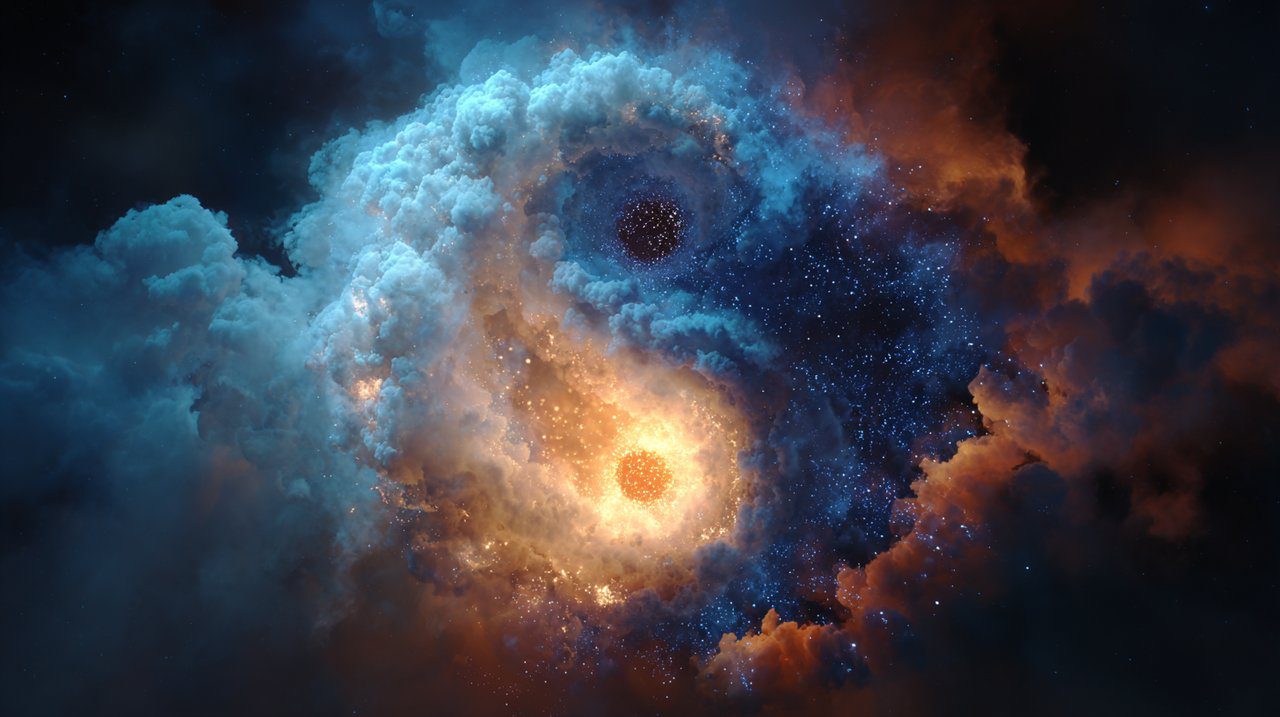Nataraja’s Cosmic Ballet: A Guide to Shiva’s Dance of Existence
Have you ever watched a still pond, and noticed how a single ripple, once it begins, touches every part of the surface, reflecting the vast sky above? It makes one wonder: can the universe’s grand, unending dance of creation and dissolution ever truly be held in a single, quiet moment? The Nataraja statue, a beautiful depiction of Shiva, the cosmic dancer, seems to whisper an answer, showing us the universe’s ceaseless motion captured in one powerful, yet peaceful, form.

The Cosmic Rhythm: Nataraja’s Eternal Dance
Just as a quiet stream patiently carves its path through ancient stone, shaping the landscape over countless seasons, so too does the universe move in an unending, profound rhythm. The Nataraja statue doesn’t just show us this; it invites us to feel this fundamental truth, laying bare a visual philosophy of cosmic cycles.
The Lord of the Dance: Shiva as Nataraja
In Hinduism, Shiva is often seen as the destroyer, much like a winter’s frost that brings down the old leaves. Yet, his presence is far vaster than mere ending. As Nataraja, the Lord of the Dance, he is the quiet orchestrator of the entire cosmic play, a gentle conductor of the universe’s grand performance.
Here, Nataraja stands as a living embodiment of the dynamic interplay of creation, preservation, and dissolution. This isn’t a dance of chaos, but a deeply felt, meticulously choreographed expression of universal law, as natural and inevitable as the changing tides.
The Tandava: Dance of Creation and Destruction
Shiva’s dance, known as the Tandava, is a powerful and vigorous expression, much like a storm that clears the air. It holds a dual nature, revealing two profound aspects:
- The Ananda Tandava is a dance of joy and creation, akin to the first warm rains of spring.
- The Rudra Tandava is a dance of destruction and dissolution, like the necessary decay that returns nutrients to the soil.
Both facets are not just essential; they are interconnected, like the cycle of seasons. Just as a forest fire clears old growth, making space for vibrant new life, destruction is not an end, but a vital prerequisite for regeneration.
A Universe in Motion: Decoding Nataraja’s Symbolism
If we look closely, every element woven into the Nataraja sculpture speaks a silent language. It’s like reading the subtle signs in nature, each one conveying deep truths about the cosmos and our own inner spirit. Each gesture, each attribute, contributes to a complete, unfolding narrative of universal activity.
The Drum and Flame: Creation and Annihilation
In one upper hand, Nataraja holds a small drum, the damaru. Its rhythmic beat is like the very first pulse of the universe, symbolizing the primordial sound of creation, from which all life gently unfolds. In the other, a cradled flame, agni, dances. This flame is the quiet symbol of the power of dissolution and transformation.
Like a forest clearing itself after a long season, this fire consumes all that is old, yet from its warm ashes, new and vibrant forms inevitably arise.
Abhaya Mudra and Gajahasta: Protection and Liberation
One lower hand is raised in the abhaya mudra, a gesture as steady as a mountain, signifying fearlessness and protection. It’s a gentle reassurance that in the face of the cosmic dance, there is no need for fear.
His other hand, extended gracefully downwards, points towards his raised foot, forming the gajahasta mudra. This is like an open path through the woods, inviting all to find refuge and, ultimately, to discover liberation from the endless cycle of birth and death.
Apasmara: The Dwarf of Ignorance
Look beneath Nataraja’s dancing foot, and you’ll see a dwarf-like figure, Apasmara. This isn’t a fierce struggle; it simply represents ignorance and forgetfulness, which Shiva gently, yet powerfully, holds beneath him.
His effortless triumph over Apasmara is like the quiet dawn pushing away the night’s shadows. It signifies the spiritual awakening that comes when we gently overcome the darkness of illusion, allowing clarity to emerge.
The Ring of Fire: Cosmic Cycles
Encircling Nataraja is a grand arch of flames, the prabhamandala. This ring is not a barrier, but a beautiful, ever-moving horizon, symbolizing the entire cosmos, constantly in flux.
It speaks of the endless cycles of creation, preservation, and destruction that define our universe—a perpetual dance of being and non-being, as natural and unending as the ocean’s tides.
Echoes of Balance: Nataraja, Taoism, and the Yin Yang
Across the vast landscapes of human thought, in different cultures and philosophies, there are quiet whispers of a shared understanding—a deep sense of the universe’s inherent balance. The cosmic dance of Nataraja, with its profound rhythm, finds a compelling echo in the ancient wisdom of Taoism, like two different streams flowing from the same mountain spring.
Universal Cycles: A Shared Philosophy
Just as Nataraja’s Tandava embraces both creation and destruction, Taoist philosophy gently guides us to see the ever-changing flow of the Tao, the Way of Nature. The universe, in this view, is never static; it’s a dynamic, breathing process of continuous transformation, much like the seasons.
Both traditions, in their own quiet ways, speak of a subtle, underlying order that governs all things—a natural rhythm to which all life, like a river, must eventually yield.
Finding Harmony in Contradictions
The Yin Yang symbol, a cornerstone of Taoist thought, is like a visual poem, perfectly illustrating the concept of complementary opposites within a unified whole. It’s the silent dance of light and shadow, day and night, mountain and valley.
Shiva’s dual nature—as creator and destroyer, preserver and liberator—mirrors this profound principle. These seemingly contradictory forces are not at war; they are interdependent, each essential for the cosmic harmony and balance, just as the quiet earth needs both the warmth of the sun and the coolness of the rain.

Crafting Eternity: The Art of the Bronze Sculpture
The Nataraja form, so often seen in exquisite metalwork, is more than just a beautiful object. It’s like a quiet vessel, crafted with devotion and artistry, holding within it a deep current of spiritual understanding. These sculptures are not merely decorative; they become conduits, guiding us towards deeper insights.
Ancient Craftsmanship: Preserving Sacred Form
For centuries, skilled artisans, much like patient sculptors of the earth, have cast these intricate figures. Often as bronze sculptures, they use traditional lost-wax techniques, a process that speaks of time and dedication.
The precision and devotion woven into their creation reflect a profound reverence, akin to how a gardener tends a sacred plant. Every detail—from the delicate mudras to the swirling flames—is meticulously crafted, each curve and line whispering the statue’s sacred meaning.
Cultural Significance in Hinduism
Within Hinduism, these statues hold a quiet, immense significance. They stand at the heart of temple worship, personal devotion, and moments of deep philosophical contemplation, much like a steady tree in a sacred grove.
A Nataraja statue is more than an object; it’s a tangible, ever-present reminder of the universe’s dynamic nature and the gentle, unfolding path to spiritual liberation.
Embracing the Dance: A Reflection on Cosmic Flow
So, returning to our initial question: can the universe’s grand, unending dance ever truly be held in a single, quiet moment? The Nataraja statue, with its intricate symbolism and profound philosophical underpinnings, gently invites us to look beyond the surface of existence, much like observing the subtle shifts in a landscape.
It reminds us that change is the only constant, as inevitable as the changing seasons, and that within every ending lies the quiet seed of a new beginning. Just as the patient wind shapes mountains over eons, this cosmic dance continuously reshapes our world, our lives.
Reflecting on Nataraja’s balance of creation and destruction, or the Yin Yang of Taoism, we might find ourselves with a deeper, more peaceful appreciation for the rhythms of life.
Perhaps, like the quiet observer of a forest’s autumn decay, we can learn to see beauty and purpose in every phase, understanding that even in letting go, there is a profound grace and the promise of what is yet to come.
💡 Häufig gestellte Fragen
The Nataraja statue symbolizes Lord Shiva as the cosmic dancer, embodying the eternal cycle of creation, preservation, and dissolution of the universe. It represents the ceaseless motion and rhythm of the cosmos, and Shiva's role as the orchestrator of this grand performance.
Shiva's dance, the Tandava, has a dual nature. The Ananda Tandava is a dance of joy and creation, symbolizing new beginnings, while the Rudra Tandava is a dance of destruction and dissolution, representing the necessary decay that makes way for regeneration. Both are interconnected aspects of the universal cycle.
In one upper hand, Nataraja holds the damaru, a drum whose rhythmic beat symbolizes the primordial sound of creation from which all life unfolds. In the other hand, he holds a flame (agni), which represents the power of dissolution and transformation, consuming the old to allow for new growth.
The Nataraja statue's depiction of complementary forces like creation and destruction finds resonance with Taoist philosophy, which emphasizes the dynamic flow of the Tao. The statue's dual nature mirrors the Yin Yang symbol, illustrating how seemingly contradictory forces are interdependent and essential for cosmic harmony and balance.
The dwarf-like figure, Apasmara, beneath Nataraja's dancing foot represents ignorance and forgetfulness. Shiva's gentle yet powerful control over Apasmara symbolizes the triumph of spiritual awakening and clarity over illusion and darkness.








